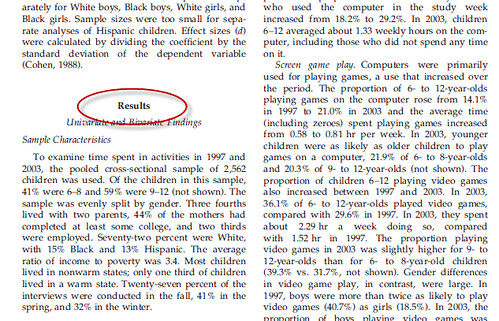For a quick overview of the parts of a scholarly article, click on the link below to see an example of a scholarly article and its parts. We will look at the different parts more closely on the rest of this page.
An abstract is a summary of the main article. An abstract will include information about why the research study was done, what the methodology was and something about the findings of the author(s). The abstract is always at the beginning of the article and will either be labeled "abstract" or will be set apart from the rest of the article by a different font or margins.

The abstract should tell you what the research study is about, how the research was done (methodology), who the research sample was, what the authors found out and why this is important to the field.
Most articles will start with an introductory section, which may be labeled introduction. This section introduces the research study, the thesis statement and why the research being conducted is important.
Questions to ask while you read:

The literature review section of an article is a summary or analysis of all the research the author read before doing their own research. This section may be part of the introduction or in a section called Background. It provides the background on who has done related research, what that research has or has not uncovered, and how the current research contributes to the conversation on the topic. When you read the literature review ask:

The literature review is also a good place to find other sources you may want to read on this topic to help you get the bigger picture.
The methodology section or methods section tells you how the author(s) went about doing their research. It should let you know a) what method they used to gather data (survey, interviews, experiments, etc.), why they chose this method, and what the limitations are to this method.
The methodology section should be detailed enough that another researcher could replicate the study described. When you read the methodology or methods section:

A good researcher will always let you know about the limitations of their research.
The results section in a scholarly article is where the author(s) talk about what they found in their research study. Most scholarly articles will have a section labeled results or findings.

Research articles are full of data. The data should be complete and directly support the conclusions the authors' draw about their research question.
Tables, graphs, and charts are good indicators that this is a research article. The tables should represent the data in a clear and readable manner.

The discussion section is where the author(s) write about what they found and what they think it means. The authors may also draw some conclusions about the research and what significance it has in this section. This section will also tell you what some of the issues were with the research or using a specific population for a research study.

The final section is usually called the conclusion or recommendations. Here is where the authors summarize what they found, why they think their research is significant and, if appropriate, make recommendations about future actions or future research that needs to be conducted. In some cases, the conclusion is part of the discussion section.
At the end of a scholarly article, you will find a list of the works cited by the author(s). This list is called a reference list, works cited or bibliography. In scholarly articles, this list will generally be quite long and include articles, books, and other sources.

When you look at the references, take a look at the dates of the articles and books listed. Are they recent? Does this list include both historic and current articles? If you know something about the topic, do you recognize any of the authors listed?
